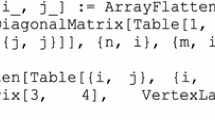Abstract
The identification and interpretation of regional economic structure is addressed by reference to a four region, three sector interregional input-output table for the US for 1982. Using the transactions matrix, a succession of self-influence feedback loops are identified, first at the macro-regional level (where all transactions are aggregated into one sector) and, subsequently, with more sectoral detail. The feedback loops are extracted hierarchically using the Matrioshka Hierarchical Feedback Loop Principle. The empirical results reveal the domination of domestic (intra-regional flows) and the dominant role that region 4 (Rest of the US) plays in the bi-lateral trading patterns. However, when sectoral flows are introduced to the intra- and inter-regional flows, the pattern of feedback loops becomes more complex, although the overall pattern matches the structure of the aggregate transactions flows. The analysis provides insights into structure and spatial linkages that cannot be revealed from the more usual data sources (such as the distribution of employment by sector). With tables available for more than one time period, it would be possible to examine structural changes in a more complete fashion.
Similar content being viewed by others
References
Bureau of Economic Analysis (1992) Gross State Product Series. US Department of Commerce, Washington, DC
Danzig G (1963) Linear programming and Extensions. Princeton, NJ, Princeton University Press
Gillen WJ, Guccione A (1980) Inter-regional feedbacks in input-output model: some formal results. J Reg Sci 20:477–482
Greytak D (1970) Regional impact of inter-regional trade in input-output analysis. Pap Reg Sci Assoc 25:203–217
Greytak D (1974) Regional interindustry multipliers: an analysis of information. Reg Sci Urban Econ 4:163–172
Guccione A, Gillen WJ, Blair PD, Miller RE (1988) Inter-regional feedbacks in input-output models: the least upper bound. J Reg Sci 28:397–404
Hewings GJD, Gazel R (1993) Regional and interregional impacts of the US-Canada Free Trade Agreement. Discussion Paper 93-P-1. Regional Economics Applications Laboratory, University of Illinois, Urbana
Hewings GJD, Sonis M, Lee J-K, Jahan S (1995) The structure of the Bangladesh interregional social accounting system: a comparison of alternative decompositions. In: Hewings GJD, Madden M (eds) Essays in Honour of Sir Richard Stone. Cambridge, Cambridge University Press
Hulu E, Hewings GJD (1993) The development and use of inter-regional input-output models under conditions of limited information. Rev Urb Reg Dev Stud 5:135–153
Krugman P (1991) Is bilateralism bad? In: Helpman E, Razin A (eds) International Trade and Trade Policy. Cambridge, MIT Press, pp 9–23
Krugman P (1993a) Regionalism versus multilateralism: analytical notes. In: De Melo J, Panagariya A (eds) New Dimensions in Regional Integration. Cambridge, Cambridge University Press, pp 58–79
Krugman P (1993b) The narrow and broad arguments for free trade. Am Econ Rev 83:17–28
Metzler LA (1950) A multiple-region theory of income and trade. Econometrica 18:329–354
Miller RE (1966) Inter-regional feedback effects in input-output models: a reappraisal. In: Perlman M, Leven CL, Chinitz B (eds) Spatial, Regional and Population Economics. New York, Gordon and Breach, pp 263–292
Miller RE (1969) Inter-regional feedbacks in input-output models: some empirical results. Western Econ J 7:41–50
Miller RE (1986) Upper bounds on the sizes of inter-regional feedbacks in multiregional input-output models. J Reg Sci 26:285–306
Round JI (1978) An Inter-regional Input-Output Approach to the Evaluation of Nonsurvey Methods. J Reg Sci 18:179–194
Round JI (1979) Compensating Feedback Effects in Inter-regional Input-Output Models. J Reg Sci 19:145–155
Round JI (1983) Nonsurvey Techniques: A Critical Review of the Theory and the Evidence. Int Reg Sci Rev 8:189–212
Round JI (1988) Incorporating the International, Regional and Spatial Dimension into a SAM: Some Methods and Applications. In: Harrigan FJ, McGregor PG (eds) Recent Advances in Regional Economic Modeling. London, Pion
Sommer J, Hicks DA (eds) Rediscovering Urban America. Washington DC, US Department of Housing and Urban Development
Sonis M, Hewings GJD (1990) The ‘Matrioshka’ principle in the hierarchical decomposition of multiregional social accounting system. In: Anselin L, Madden M (eds) New Directions in Regional Analysis: Integrated and Multiregional Approaches. London, Pinter
Sonis M, Hewings GJD (1993c) Hierarchies of Regional Sub-Structures and their Multipliers within Input-Output Systems: Miyazawa Revisited. Hitotsubashi J Econ 34:33–44
Sonis M, Hewings GJD (1994) Matrix sensitivity, error analysis and internal/external multiregional multipliers. Discussion Paper 94-T-6, Regional Economics Applications Laboratory, University of Illinois, USA
Sonis M, Oosterhaven J, Hewings GJD (1993a) Spatial economic structure and structural changes in the European Common Market: Feedback Loop input-output analysis. Econ Syst Res 5:173–184
Sonis M, Hewings GJD, Lee J-K (1993b) Interpreting spatial economic structure and spatial multipliers: three perspectives. Geogr Anal 26:124–151
Author information
Authors and Affiliations
Additional information
The data used in this analysis were prepared as part of an interregional computable general equilibrium model funded in part by grants from the Economic Development Administration, U.S. Department of Commerce and the Canadian Embassy. However, the views and interpretation expressed herein are those of the authors.
Rights and permissions
About this article
Cite this article
Sonis, M., Hewings, G.J.D. & Gazel, R. The structure of multi-regional trade flows: hierarchy, feedbacks and spatial linkages. Ann Reg Sci 29, 409–430 (1995). https://doi.org/10.1007/BF01581885
Received:
Accepted:
Issue Date:
DOI: https://doi.org/10.1007/BF01581885




